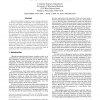Free Online Productivity Tools
i2Speak
i2Symbol
i2OCR
iTex2Img
iWeb2Print
iWeb2Shot
i2Type
iPdf2Split
iPdf2Merge
i2Bopomofo
i2Arabic
i2Style
i2Image
i2PDF
iLatex2Rtf
Sci2ools
70
Voted
ISCA
1997
IEEE
1997
IEEE
DataScalar Architectures
DataScalar architectures improve memory system performance by running computation redundantly across multiple processors, which are each tightly coupled with an associated memory. The program data set (and/or text) is distributed across these memories. In this execution model, each processor broadcasts operands it loads from its local memory to all other units. In this paper, we describe the benefits, costs, and problems associated with the DataScalar model. We also present simulation results of one possible implementation of a DataScalar system. In our simulated implementation, six unmodified SPEC95 binaries ran from 7% slower to 50% faster on two nodes, and from 9% to 100% faster on four nodes, than on a system with a comparable, more traditional memory system. Our intuition and results show that DataScalar architectures work best with codes for which traditional parallelization techniques fail. We conclude with a discussion of how DataScalar systems may accommodate traditional pa...
Architectures Improve Memory | DataScalar Architectures | Hardware | ISCA 1997 | Processor Broadcasts Operands |
| Added | 06 Aug 2010 |
| Updated | 06 Aug 2010 |
| Type | Conference |
| Year | 1997 |
| Where | ISCA |
| Authors | Doug Burger, Stefanos Kaxiras, James R. Goodman |
Comments (0)

